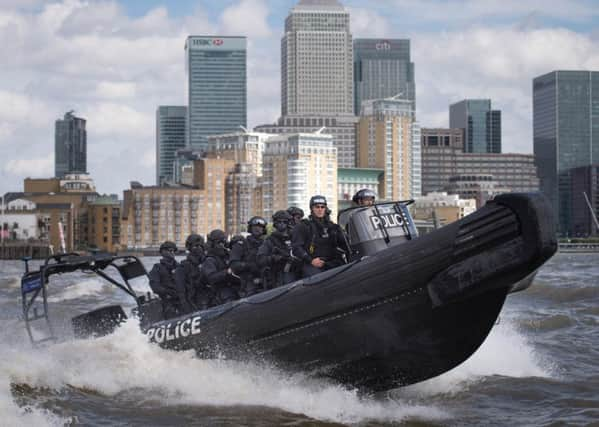Andrew Vine: Arming police is the price of safety in times of terror


Faces masked, carrying automatic weapons, looking more like special forces than police officers, 600 of them are deployed across London’s tourist hotspots to guard against terrorism.
And where the capital leads, can the cities of Yorkshire be far behind in the face of this ever-more unpredictable threat?
Advertisement
Hide AdAdvertisement
Hide AdThis is a watershed moment. Our police have hitherto shunned the militaristic image of their counterparts across most of the rest of the world.
They are a resolutely civilian service, which makes officers infinitely more approachable and better able to forge links with the communities they serve and protect.
But there is no dialogue to be had with those who threaten us, no possibility of negotiation or compromise.
The deployment of armed officers is the starkest reminder yet that in the event of an attack, the only option is to kill, however alien that feels in a society where guns play little part in our culture.
Advertisement
Hide AdAdvertisement
Hide AdBritain has the most sensible attitude of any country towards firearms, an abhorrence of them in the wrong hands, and within the police a sober restraint towards their use that renders them the very last resort.
That was underlined by Home Office figures released last month, showing that police fired shots on only seven occasions in more than 14,000 armed operations during the previous year.
Yet just as the traditional police truncheon gave way to the much more formidable extendable baton in increasingly violent times, and then CS spray and Tasers were added to the armoury of officers, so an evolving terrorist threat makes this further, reluctant, step necessary.
We have grown used to seeing armed police at our airports in the 15 years since the 2001 terrorist attacks on the United States. So too at major public occasions and national sporting events.
Advertisement
Hide AdAdvertisement
Hide AdIt was never going to be a long stride from there to the same presence being visible on the streets. The need to have more firearms officers ready to confront terrorists in the face of a growing threat has already been acknowledged by the Government. In April, it announced the number trained to use firearms will increase by 1,500, taking the national total to just over 7,000.
Even so, the Police Firearms Officers Association has warned that they will be thinly spread, and if a terrorist attack happened in an isolated rural area, it might take up to 45 minutes to respond.
And there is no reason why the vicious, cowardly, nihilistic followers of so-called Islamic State should not regard such a location as a soft target.
The murder of 85-year-old Father Jacques Hamel at the altar of his own church took place in the small French town of St-Etienne-du-Rouvray. Similarly, the quiet Bavarian town of Ansbach was the target of a suicide bomber.
Advertisement
Hide AdAdvertisement
Hide AdIt is inevitable that Britain will be targeted at some point. The threat is higher than ever before.
Our intelligence about terrorist plots has so far been superior to that of France or Germany – to a significant degree because of the painful lessons learned from the failure to detect and prevent the 2005 London Underground and bus attacks, which resulted in much improved co-operation between security agencies. Yet what the recent attacks in Europe tell us is that the nature of the threat is changing.
Elaborate plots involving multiple people that take time to come to fruition and involve obtaining guns or explosives appear to be giving way to attacks by individuals or very small groups.
And these self-radicalised terrorists are turning to everyday means in order to kill, like the Bastille Day attacker in Nice using a lorry to mow down more than 80 people. Such lone wolves are much harder to identify, and their presence puts security services in the uneasy position of having to react to atrocities rather than take the fight to the terrorists.
Advertisement
Hide AdAdvertisement
Hide AdConfronted by an increasingly difficult to anticipate threat, visible deterrence and the ability to respond immediately with lethal force assume much greater importance.
France has already introduced armed guards at popular tourist destinations and beaches, amid fears that visitors – amongst them an estimated three million Britons this summer – could be targets.
We remain a long way from the arming of all officers. There is no appetite for that within the police, nor the political will to do it, for it would fundamentally change the face of the service. But the face of the threat to us has changed, too. The sight of officers with guns scanning passengers at airports or spectators entering sports stadiums once prompted a jolt of uneasiness because of its unfamiliarity.
It doesn’t any more. We’ve grown used to it. And given how terrorism is mutating into an ever more unpredictable form, the time has come when we must grow used to it on our streets as well.